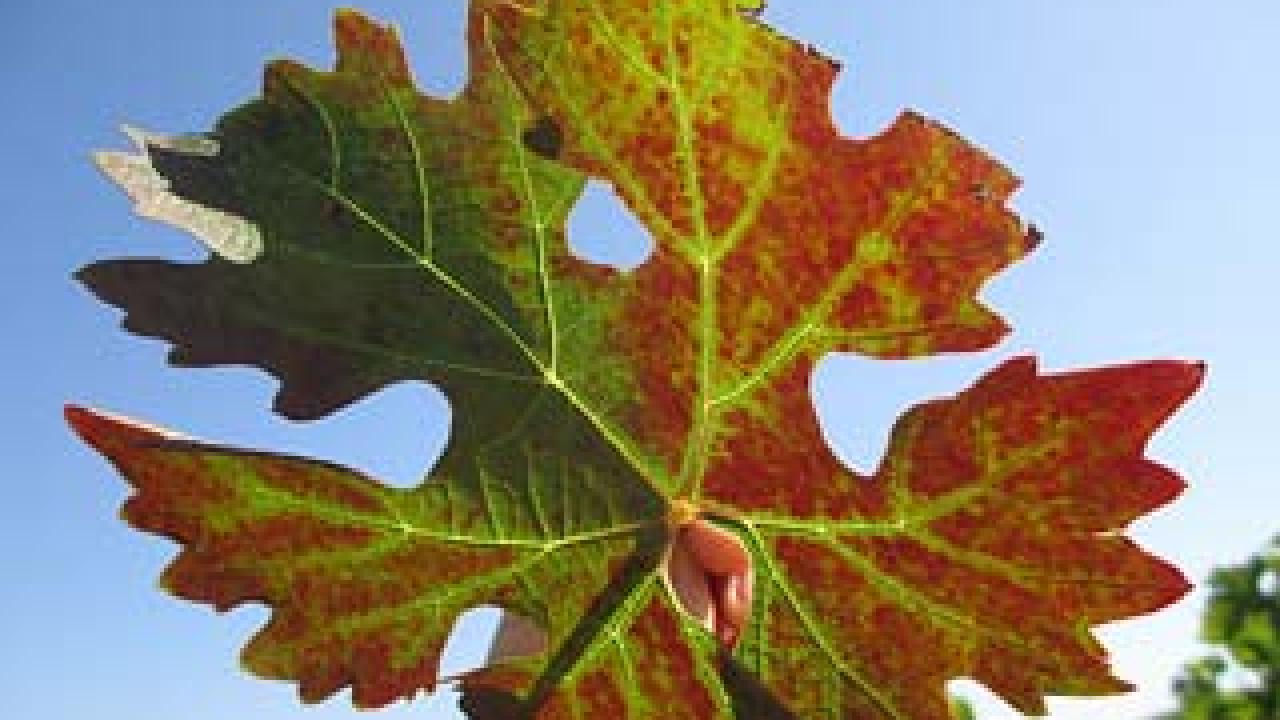Providing disease-free grapevines and rootstock to California’s famed North Coast wine region is more than a good idea — it’s money-wise to the tune of more than $60 million annually, according to a report from researchers at the University of California, Davis.
To quantify this benefit, the researchers developed an economic framework to conduct a case study of grapevine leafroll-3, the dominant grapevine virus in California and worldwide. They report their findings in a working paper released by the Center for Wine Economics at UC Davis’ Robert Mondavi Institute for Wine and Food Science. The complete paper is available online.
“This analysis places a dollar value on the efforts to prevent the spread of just a single disease in a single grape-growing region,” said Kate Binzen Fuller, the study’s lead author and a postdoctoral scholar in the Department of Agricultural and Resource Economics and Foundation Plant Services at UC Davis. “The overall benefits of such testing and certification are, in fact, dramatically higher,” she said.
Fuller added that the study revealed that the monetary benefits of such screening efforts far outweigh the costs related to screening and vine replacement.
“Even if growers have to pay a premium for certified, virus-free vines, this study suggests that they will receive a very large benefit. For the scenarios we evaluated, benefits are between six and 10 times the cost,” she said.
Viral threat to grapevines
Viruses and related disease-causing microbes pose a serious threat to agriculture because there are no effective controls available to growers, other than destroying infected plants. In the case of grapevines, viruses typically spread over long distances through the movement of infected plants or the use of infected cuttings and rootstock for propagating new plants.
Grapevine leafroll-3 appears in multiple strains, most causing leaves to redden and roll under along the edges. The disease diminishes fruit production and quality as grapes develop less pigmentation and sugar and mature more slowly. Growers have reported drops in yield of 30 percent and more; in some cases the disease even causes the plant graft to fail, killing the young vine.
The virus primarily is transmitted to the vine by mealybugs, tiny insects that are commonly found in California vineyards. Growers try to prevent grapevine leafroll-3 by testing their existing vines, using virus-free rootstocks and cuttings to grow new vines, removing diseased vines and spraying for mealybugs.
Screening plants for viruses
To prevent the introduction and spread of such viruses in grapevines, several clean-plant centers have been established throughout the United States, in partnership with the U.S. Department of Agriculture, to provide a large inventory of virus-screened plants to agricultural nurseries and growers.
In California, the Foundation Plant Services at UC Davis is responsible for screening and reproducing healthy, disease-free grapevines, as well as strawberries, fruit and nut trees, roses and sweet potatoes.
This meticulous process takes five to nine years and is costly, with expenses covered by revenue from plant sales to nurseries, several types of plant user fees, as well as custom contracts and virus testing.
Costs and benefits
The economic model created for this study by the UC Davis researchers compared the estimated value of losses incurred by North Coast winegrape growers due to grapevine leafroll disease with the estimated benefits realized by using vines that were certified to be virus-free. They did this by estimating what a grower’s net revenue would be in several different scenarios, based on initial disease appearance, disease spread, use of certified or noncertified vines, and replacement or nonreplacement of diseased vines.
“Results from applying this model indicate that, for the scenarios we examined, the most economically beneficial strategy is to plant initially with certified clean vines and to replace any vines that become diseased also with certified clean vines,” said study co-author Deborah Golino, a Cooperative Extension plant disease specialist and the director of Foundation Plant Services.
The researchers found that the average annual benefit to a grower from replacing diseased vines in a vineyard was 39 cents per vine or $512 per acre, if noncertified vines or rootstocks were used in both the initial and replacement plantings. The benefit for replanting diseased vines climbed to 55 cents per vine or $727 per acre if certified plant material was used to both plant and replant the vineyard.
Overall, the researchers estimate that, for just grapevine leafroll-3 virus, the vine certification program yields a benefit of between 30 cents and 47 cents per vine, or between $401 and $616 per acre. If all growers in the region were to use certified planting stock, this would translate to a benefit of between $40.4 and $61.8 million per year for the North Coast region. This benefit translates to between 4.8 percent and 7.4 percent of the wine grape revenue for that region.
Media Resources
Pat Bailey, Research news (emphasis: agricultural and nutritional sciences, and veterinary medicine), 530-219-9640, pjbailey@ucdavis.edu
Kate Binzen Fuller, Agricultural and Resource Economics, (530) 344-3342, kbfuller@ucdavis.edu
Julian Alston, Agricultural and Resource Economics, (530) 752-3283, julian@primal.ucdavis.edu
Deborah Golino, Foundation Plant Services, (530) 754-8102, dagolino@ucdavis.edu
